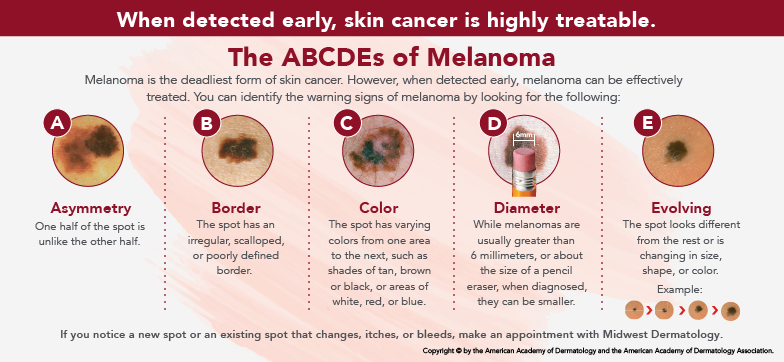THE SERIOUS SIDE OF SKIN CANCER

It’s important to have your skin examined by a dermatologist regularly to learn when normal spots turn into something more serious.
Remember, when it comes to skin cancer, knowing what’s less serious, what needs to be monitored and what needs immediate attention from a physician is really important. In fact, the only thing worse than going to a doctor when you don’t need to is finding out you should have made an appointment much earlier than you did!
Schedule an appointment with one of our board-certified dermatologists if you have a suspicious lesion. Midwest Dermatology can provide effective treatment for precancerous and cancerous skin growths that fall across the skin cancer spectrum.
KNOW YOUR ABC’S
When it comes to skin cancer, knowledge is key. Like being smart when out in the sun, and being diligent about scheduling your annual skin exam. Equally important is doing your homework about the ABC(DE’s) of melanoma . When it comes to melanoma, the most serious form of skin cancer, one of the best ways to prevent it is to know what these letters mean and use them as a checklist to evaluate suspicious spots and moles on your skin.
A Asymmetry – Does one side of the mole not match the other
B Border – Are the edges of the mole blurred, ragged or uneven?
C Color – Are there multiple colors within one mole? Is it an unusual color? Look for shades of black, brown, pink, red, blue or even white.
D – Diameter and Darkness – While it’s ideal to detect a melanoma when it is small, it’s a warning sign if a lesion is the size of a pencil eraser (about 6 mm, or ¼ inch in diameter) or larger. Some experts say it is important to look for any lesion, no matter what size, that is darker than others. On the opposite end of the color spectrum, amelanotic melanomas are colorless.
E – Evolving – Is the mole new? Has its size, shape or color changed recently?
It all starts with prevention
Sun exposure – the leading cause of skin cancer – is cumulative. Repeated exposure and repeated overexposure throughout our lifetime adds up. Sun protection is the first line of defense, so start by focusing on prevention. To protect your skin, Midwest Dermatology recommends you practice these common-sense habits:
- Stay out of the sun (if you can) between 10 a.m. and 2 p.m., when the sun’s rays are at their strongest.
- Wear sunscreen that’s at least 30 SPF. Bump that up to a water-resistant sunscreen with a minimum SPF of 50 if you are planning outdoor activities, especially around water.
- Cover your body with lightweight, long sleeve shirts and pants.
- Wear a hat.
- Avoid tanning.
THE DARK SIDE OF MOLES
Many, but not all, melanomas of the skin start inside previously normal moles. They can occur anywhere on the skin but are most commonly seen on the chest and back in men and on the legs in women.
If you see a new spot on your skin, examine it closely. If it looks different from all other spots on your skin, consider it a warning sign of melanoma and have it checked out at Midwest Dermatology.
PHYSICIANS EXAMS REDUCE RISK
The success of melanoma treatment often depends on when the disease is found. In fact, research presented by The American Academy of Dermatology shows that a single skin exam may significantly reduce odds of being diagnosed with advanced melanoma. The study involved a review of more than 400 melanoma cases by University of Pennsylvania researchers, showed that patients who had at least one visit to a dermatologist were 37 percent less likely to have a diagnosis of invasive melanoma.
If discovered and diagnosed in its earliest stages, melanoma can often be treated very effectively with surgery. If found in later stages, a diagnosis of melanoma may require a referral to other doctors for a combination of cancer treatments.
You can help Midwest Dermatology extinguish melanoma by knowing your risk factors and being vigilant about the spots on your body.
Call (402) 933-0800 to schedule your appointment with a Midwest Dermatology physician. Or schedule on line by visiting midwestderm.com.
